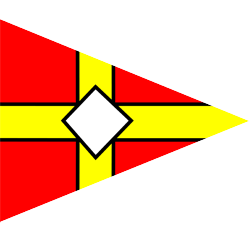The club welcomes members with all types of sailing boat. However, some classes are particularly popular among members and these are explained below.
Enterprise
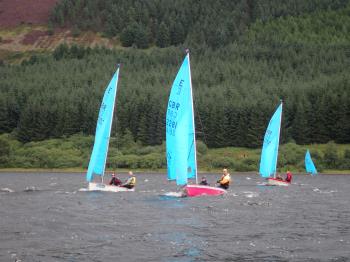
The Enterprise dinghy is one of the classes officially supported by the club and is well represented in both club racing and at the main club events. Recognised on the loch by its distinctive blue sails, the Enterprise dinghy is a two person, non trapeze, non spinnaker one design double chine hull dinghy.
Designed by Jack Holt in 1956, the design has withstood the test of time and the class provides some excellent sailing and racing at St Mary’s as it can perform well in almost all wind conditions. Enterprises are not only for racing and also make good cruising boats for all the family.
You can find more information about sailing an Enterprise here.
Mirror
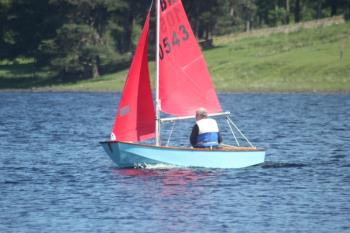
There are a lot of Mirror dinghies in the boat park at St Mary’s and its distinctive red sails can usually be seen cruising on the loch. As an official club class the Mirror dinghy is represented at main club events and there is also a racing series throughout the year.
The Mirror is a small, light, easy to sail, easy to transport, pram dinghy. Basically a stable family boat for all ages and abilities, ideal for just “messing about” and its ease of handling makes it a very good single-hander.
The Mirror was named after the Daily Mirror newspaper. From the start it was promoted as an affordable boat, and it has probably done more than any other design to make dinghy sailing in the UK a sport available to anyone. Although most popular in the UK, Mirrors are also used in other countries, notably Australia.
It was designed by Jack Holt and TV DIY expert Barry Bucknell in 1962, the Mirror employed a novel construction method where sheets of marine plywood are held together with copper stitching and fibreglass tape. Buoyancy is provided by integral chambers rather than by bags. It was originally designed to be built with simple tools and little experience, and this meant that the design was quite unsophisticated – for example, a simple dagger board is used instead of a hinged centreboard.
The result, however, was a robust and versatile boat that can be easily maintained, and repaired, and can also be got into the water very quickly from storage or transport. Its standing lug rig, with a gaff that effectively doubles the height of the mast, means that the spars can be packed inside the hull for easy storage or transportation.
You can find more information about about sailing a Mirror here.
Solo
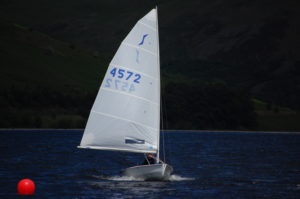
The development of single hander classes at the club has lead to the adoption of the Solo as an official club class. Solo sailors at the club are very competitive in both club racing and in the traveller series. Solos are represented at all major club events with fleet racing taking place every Sunday throughout the year. The National Solo dinghy is a classic, one-design, single handed dinghy.
Designed by Jack Holt in 1956, the Solo dinghy still remains popular today. While quite lively the Solo dinghy is not as physically demanding as a Laser or many of the other single crew designs. It is available in wood, composite or fibreglass and developments in rig technology mean that it can be sailed competitively by helms from nine and a half to sixteen stones.
You can find more information about sailing a Solo here.
Laser
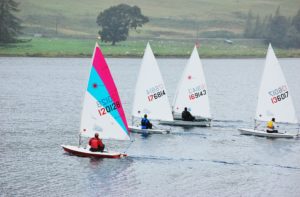
The Laser dinghy is an official club class and represented at club events. The Laser is a popular dinghy at St Mary’s and regular club racing is available. The Laser is a one-design class of small sailing dinghy. It is a single handed boat, meaning that it is sailed by one person.
The design, by Bruce Kirby, emphasizes simplicity and performance. Three simple, interchangeable rigs take the growing sailor from the Optimist to an introduction to youth sailing with the 4.7 rig and then to full youth sailing in the Radial (5.7m2) with the final step to the full rig (7.06m2). A unique step-by-step progression in the same equipment in the same Class with the only difference being the sail and lower mast. Over 190,000 Lasers have been built. Due to its relatively low cost, responsive handling and single-design restrictions, it is the most widely-owned small dinghy in the world, and the most popular racing class.
You can find more information about sailing a Laser here.
Topper
The Topper dinghy is not an official club class and is not represented at club events. However, the Topper dinghy is the mainstay for teenagers of the junior training fleet.
The Topper is car-toppable (hence the name!) and can be rigged in a matter of minutes, sailed, and righted by a child. The boat is stronger and lighter than any other comparable boat and is easy to handle on the water and ashore.
The Topper is virtually maintenance free and its proven track record of reliability means that it is very popular with families. The Topper has become one of the top racing classes of it’s type within the U.K.
You can find more information about sailing a Topper here.
Optimist
The Optimist dinghy is not an official club class and is not represented at club events. However, the Optimist is sturdy, safe dinghy in which our youngest members start their sail training and take to the water.
Regular junior training events allow young sailors to develop their skills and junior racing is also available for this class. The Optimist dinghy has been described as the dinghy in which the young people of the world learn to sail. It is sailed in over 110 countries by over 150,000 young people, it is the only dinghy approved by the International Sailing Federation exclusively for sailors under 16 years of age.
The Optimist dinghy was designed by Clark Mills in Clearwater, Florida. It is a single sailor, 2.3m by 1.13m flat bottomed, hard-chine, pram-bowed dinghy. The boat weighs 35kg and is easily car topped. The Optimist is a very stable vessel, which is difficult to capsize even in strong winds. They are light and easily manipulated by an instructor in a safety boat. They rescue easily, and can be bailed by a junior sailor.
You can find more information about sailing an Optimist here.
